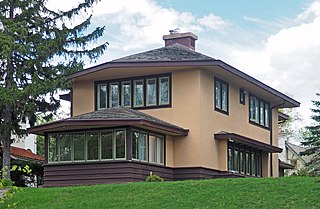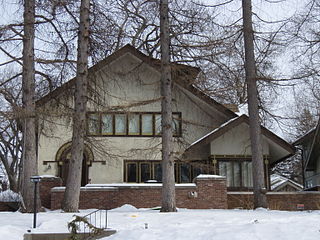
East Isles is a neighborhood within the larger Calhoun-Isles community in Minneapolis, Minnesota, United States. The neighborhood was originally a part of the more historically affluent neighborhoods around Lake of the Isles: Kenwood and Lowry Hill. However, since the 1940s, it has become more urbanized than the rest of the community, since numerous apartment buildings have been built in the area. But, old mansions still can be found hidden in the neighborhood.

Prairie School is a late 19th and early 20th-century architectural style, most common in the Midwestern United States. The style is usually marked by horizontal lines, flat or hipped roofs with broad overhanging eaves, windows grouped in horizontal bands, integration with the landscape, solid construction, craftsmanship, and discipline in the use of ornament. Horizontal lines were thought to evoke and relate to the wide, flat, treeless expanses of America's native prairie landscape.
William Gray Purcell was a Prairie School architect in the Midwestern United States. He partnered with George Grant Elmslie, and briefly with George Feick. The firm of Purcell & Elmslie produced designs for buildings in twenty-two states, Australia, and China. The firm had offices in Minneapolis, Minnesota; Chicago, Illinois; Philadelphia, Pennsylvania; and Portland, Oregon.
George Grant Elmslie was an American Prairie School architect whose works are is mostly found in the Midwestern United States. He worked with Louis Sullivan and later with William Gray Purcell as a partner in the firm Purcell & Elmslie.

The Edna S. Purcell house was designed by the firm of Purcell, Feick and Elmslie for architect William Purcell and his family in 1913. It is located in Minneapolis, Minnesota.
Purcell & Elmslie (P&E) was the most widely know iteration of a progressive American architectural practice. P&E was the second most commissioned firm of the Prairie School, after Frank Lloyd Wright. The firm in all iterations was active from 1907 to 1921, with their most famous work being done between 1913 and 1921.

Cleveland is a neighborhood in the Camden community in Minneapolis. Its boundaries are Dowling Avenue to the north, Penn Avenue North to the east, Lowry Avenue north to the south, and Xerxes Avenue North to the west. To the west of Xerxes Avenue is the suburb of Robbinsdale. Some people believe that the neighborhood is named after former United States President Grover Cleveland, while others maintain it is named after Horace Cleveland, a landscape architect who framed the development of the Minneapolis Park System in the 1880s.

The First National Bank of Mankato, also known as the Old First National Bank of Mankato and located at 229 South Front Street in Mankato, Minnesota, United States, is a fine example of Prairie School architecture in a commercial building, relating rural life to the development of downtown Mankato as a regional center of commerce and finance. The recently restored exterior is now part of the Mankato Civic Center, the Mayo Clinic Health System Event Center.

Harold C. Bradley House, also known as Mrs. Josephine Crane Bradley Residence, is a Prairie School home designed by Louis H. Sullivan and George Grant Elmslie. It is located in the University Heights Historic District of Madison, Wisconsin, United States. A National Historic Landmark, it is one of just a few residential designs by Sullivan, and one of only two Sullivan designs in Wisconsin.

The Emil J. Oberhoffer House is a historic house in Lakeville, Minnesota, United States, overlooking Orchard Lake. Emil Oberhoffer was the founder and first conductor of the Minneapolis Symphony Orchestra. The home was designed by Paul Haugen, who worked for Purcell and Elmslie, an architectural firm known for its renditions of Prairie School architecture. Later the home belonged to the parents of golfer Patty Berg.

The Dr. Ward Beebe House, also known as the John Leuthold Residence, is a three-story stucco prairie house built by Dr. Ward and Bess Beebe and designed by Purcell and Elmslie in 1912. Purcell and Elmslie were prolific designers of prairie style homes. It is located in the West Summit Avenue Historic District, in Saint Paul, Minnesota, United States.

Merchants National Bank is a bank building in Winona, Minnesota, United States, designed in the Prairie School architectural style. It was built in 1912 and features elaborate terracotta and stained-glass ornamentation. It was listed on the National Register of Historic Places in 1974 for having state-level significance in the themes of architecture and commerce. It was nominated for being the "largest and probably best example" of the 18 Midwestern banks designed by Purcell, Feick & Elmslie, a significant influence on early-20th-century American architecture. It is also a contributing property to the Winona Commercial Historic District.

The Dr. Oscar Owre House is a historic house located at 2625 Newton Venue South just north of Lake of the Isles in Minneapolis, Minnesota. It was designed by notable local architects Purcell, Feick & Elmslie in the Prairie School style.

The Charles and Grace Parker House is a house in the Lynnhurst neighborhood of Minneapolis, Minnesota southeast of Lake Harriet. It was designed by notable local architects Purcell, Feick & Elmslie in the Prairie School style. Architecture critic Larry Millett calls it one of Purcell and Elmslie's greatest houses, citing the broad gabled roof, the groupings of windows, the side porch, and the detail surrounding the entry. The entrance includes a fretsawn arch and a frieze above the door, with beams and a pair of pendants on either side. George Grant Elmslie designed the leaded glass windows. The house was listed on the National Register of Historic Places in 1992.

Stewart Memorial Presbyterian Church, now Redeemer Missionary Baptist Church, is a Prairie School church in the Lyndale neighborhood of Minneapolis, Minnesota, United States. Prairie School architecture was uncommon for use in churches. This church, which has a flat roof and broad eaves but lacks a bell tower and other traditional church features, was inspired by Frank Lloyd Wright's Unity Temple in Oak Park, Illinois. It was designed by the firm of Purcell & Feick before George Grant Elmslie became a partner of the firm. The congregation was an offshoot of First Presbyterian Church and was named after the Reverend David Stewart.

The E.S. Hoyt House is a historic house in Red Wing, Minnesota, United States, designed by the firm of Purcell & Elmslie and built in 1913. The house is listed on the National Register of Historic Places. It is also a contributing property to the Red Wing Residential Historic District.

The Ezra Abbott House is a historic house in Owatonna, Minnesota, United States. Built in 1913, it was designed by architects Purcell, Feick & Elmslie in Prairie School style patterned onto American Foursquare massing. The house was listed on the National Register of Historic Places in 1986 for having local significance in the theme of architecture. It was nominated for being a leading example of Purcell, Feick & Elmslie's residential commissions in Southeast Minnesota, and for being Steele County's most outstanding Prairie School building.

The Merton S. Goodnow House at 446 S. Main St. in Hutchinson, Minnesota was built in 1913. It was designed by Purcell, Feick & Elmslie. It was listed on the National Register of Historic Places in 1985.

The Dr. J. W. S. Gallagher House is a 1913 Prairie School house in Winona, Minnesota, United States, designed by the architectural firm of Purcell & Elmslie. The house was listed on the National Register of Historic Places in 1984 for having local significance in the theme of architecture.
Marion Parker (1873–1935) was the first female graduate in the College of Engineering and Architecture of the University of Michigan, worked with Purcell & Elmslie Architects, and established her own practice.




















